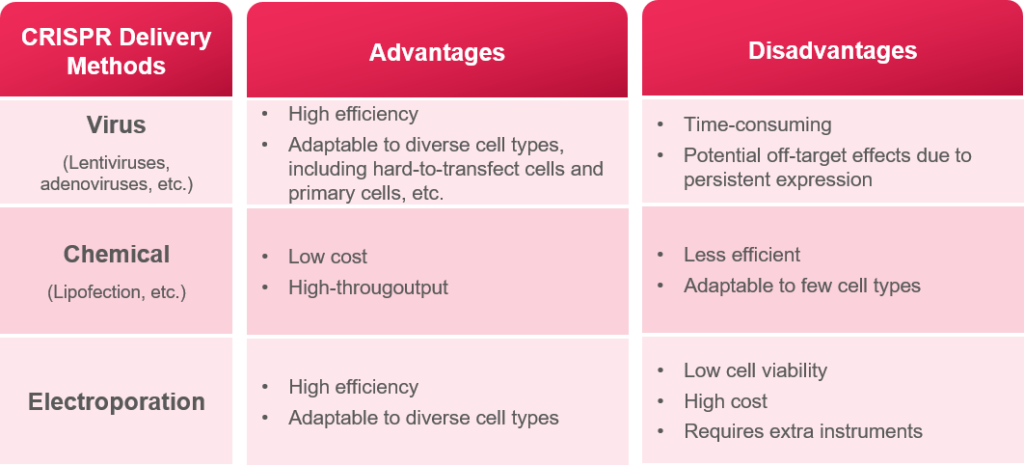BLOG
Maximizing CRISPR Editing Efficiency in Assay Cell Line Engineering
Maximizing CRISPR editing efficiency demands precision in sgRNA design, adept CRISPR delivery methods, and rigorous validation.

In the realm of genetic engineering, CRISPR technology emerges as a game-changer, revolutionizing cell line engineering with unparalleled ease. Leveraging CRISPR knock in and knockout, researchers can create enhanced disease models and generate clearer target signals, resulting in heightened accuracy and speed in the preclinical pipeline. Yet, maximizing its potential hinges on adept navigation through the complexities of effective design, delivery and validation. Join us as we unravel the strategies crucial for harnessing the full capabilities of CRISPR technology in assay cell line engineering.
1. Precision in sgRNA Design
Optimizing sgRNA design is critical for successful CRISPR/Cas9 genome editing, influencing both on-target efficiency and off-target effects. Key factors such as guide length and protospacer adjacent motif (PAM) site sequence are pivotal in ensuring optimal sgRNA performance. When designing sgRNA, it’s crucial to adhere to the following guidelines:
Maintaining a protospacer length of 20 base pairs adjacent to a PAM sequence of NGG maximizes on-target editing efficiency. Shorter sgRNAs may compromise efficacy.
Pay close attention to the PAM sequence, as it determines the target site’s accessibility for Cas9 binding and cleavage. Ensure that the selected target sequence is adjacent to a suitable PAM sequence recognized by the Cas9 enzyme (e.g., NGG for SpCas9).
Focus on targeting exons essential for protein function and avoid regions encoding amino acids near the protein’s termini to mitigate unintended consequences.
Employing multiple sgRNAs targeting the same gene enhances editing efficiency and reduces off-target effects.
Understanding how specific nucleotides within the target sequence affect cleavage efficiency informs the design of more effective sgRNAs.
Leveraging various commercial platforms offering bioinformatics tools and scorecards can aid in predicting on-target and off-target effects.
By integrating these considerations and utilizing available design resources, researchers can refine sgRNA design, thereby advancing the potential of CRISPR technology across diverse applications.
2. Efficient CRISPR Delivery Methods
The delivery of CRISPR/Cas cargo into target cells presents a multifaceted challenge, with options spanning DNA, RNA, and protein formats. From physical methods like electroporation to viral vectors such as lentiviruses, each approach offers unique advantages and considerations (see Table 1, [1]). Among these, viral vectors, particularly lentiviruses, have emerged as a preferred choice for CRISPR transfection, as it can efficiently transduce a wide range of cell types with high efficiency, including notoriously difficult primary cell lines.
Table 1: CRISPR delivery methods comparison.

3. Sufficient Screening and Validation for CRISPR Editing
Screening and validation are essential in CRISPR/Cas genome editing, although they are time and resource-intensive. According to a scientific survey, generating a CRISPR knockout cell line typically takes about five months, often with multiple restarts needed to achieve the desired outcomes [2]. However, ensuring accuracy, specificity, and safety of genetic modifications necessitates proper execution of these steps.
Initiating the process involves comprehensive analysis using molecular techniques like PCR amplification and sequencing to detect potential CRISPR-induced edits in target genomic regions. Subsequent validation assays confirm the specificity and functionality of identified edits, employing additional sequencing analyses, functional assays, or tailored biochemical assays.
Choose Acres for CRISPR Services
At Acres Biosciences, we specialize in custom CRISPR cell line generation. With our deep expertise and advanced bioinformatics tools, we guarantee accuracy and efficiency in CRISPR services. Moreover, our assay development scientists provide diverse methods to meet your validation and downstream assay needs, ensuring robust and reliable results for research or therapeutic applications.
Learn more about our cell line engineering and assay development services.
Download our blog
Unlock valuable insights and elevate your knowledge in cell engineering and assay development!
Related Resources
Related Links
Let's stay connected!
Stay updated with the latest news, resources, and exclusive offers by subscribing to our site today!